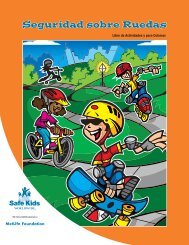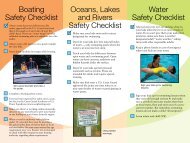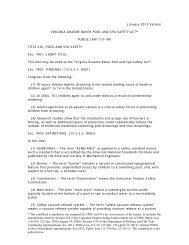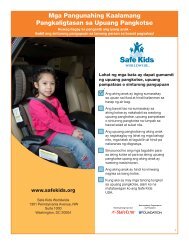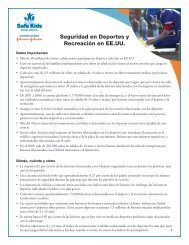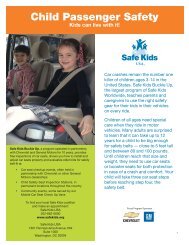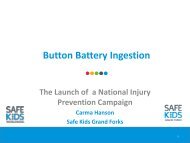Sports Safety Tips - Safe Kids Worldwide
Sports Safety Tips - Safe Kids Worldwide
Sports Safety Tips - Safe Kids Worldwide
- No tags were found...
Create successful ePaper yourself
Turn your PDF publications into a flip-book with our unique Google optimized e-Paper software.
Wear Appropriate<strong>Sports</strong> Gear• Having kids wearthe appropriate andproperly-fitted sportsgear during practiceand games can helpavoid minor andserious injuries.• Make sure athletes have the right equipmentand are wearing it for both practices and games.The right equipment may include helmets, shinguards, mouth guards, ankle braces, shoes withrubber cleats and sunscreen.Don’t Take Chances with the Brain: Knowthe Signs and Symptoms of Concussions• Learn the signs and symptoms of a concussion.This information is important for coaches, parentsand athletes.• A player with a suspected concussion mustbe immediately sidelined until evaluated andreleased by a medical professional. The importantthing is to protect players who have had aconcussion from getting another one.• A good rule of thumb: when in doubt, sit themout.Make Rest a Priority• To help avoid overuseinjury, rest all playersduring practices andgames.• Encourage playersto communicateany pain, injury orillness they may haveduring or after any practices or games. Make surethey know it’s smart to tell coaches, parents oranother adult if they’re hurt or not feeling well.• <strong>Kids</strong> should have at least one or two days offfrom any particular sport each week.• An off-season is important, too. It isrecommended that kids get 10 consecutive weeksof rest from any one sport every year. Playingdifferent sports throughout the year is OK.Be a Prepared Coach• As a coach, establishsafety guidelines thatathletes and parentscan follow duringevery practice andgame, such as creatinghydration breaks,encouraging playersto sit out if injured, resting if not feeling well andfacilitating a proper warm-up.• It’s also a good idea for coaches to get certifiedin first aid and CPR and have a stocked first aid kithandy at all practices and games.• Coaches should consider adding to their sportsskills and knowledge with free sports safetytraining at a <strong>Safe</strong> <strong>Kids</strong> <strong>Sports</strong> <strong><strong>Safe</strong>ty</strong> Clinic.Be a Supportive Parent• Learn ways to help your child stay injury free andhealthy while playing sports.• Attend a sports safety clinic in your area. Theseclinics, such as ones held by <strong>Safe</strong> <strong>Kids</strong> across theUnited States, provide coaches and parents withways to keep young athletes healthy and injuryfree throughout their sporting careers.• Visit www.safekids.org/sports to receive more tipsand resources on youth sports safety and to finda sports safety clinic or <strong>Safe</strong> <strong>Kids</strong> coalition nearyou.© 2013 <strong>Safe</strong> <strong>Kids</strong> <strong>Worldwide</strong> ®For more information visit safekids.org.





